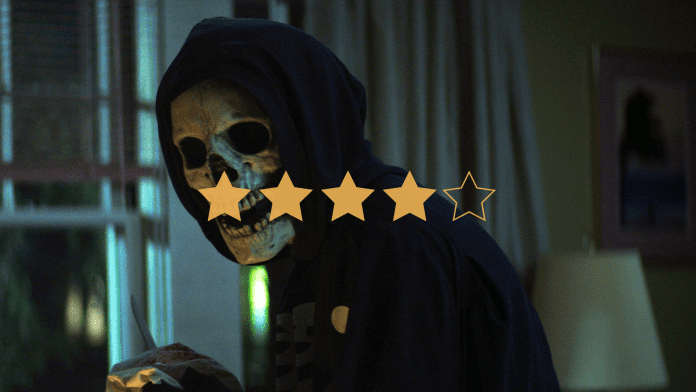★★★★✰
The Fear Street Trilogy is a new teen slasher series complete with charming throwbacks, plenty of gore, and a cast of characters you’ll be rooting for all the way.
The real world might feel scary enough right now but, if you’re after more things to keep you up at night, Netflix has released a trio of new teen-slasher movies; Fear Street Part 1: 1994, Fear Street Part 2: 1978, and finally Fear Street Part 3: 1666.
Based on the teen horror stories of the same name by R.L Stine, the three films follow a group of teenagers in Shadyside, Ohio, who are terrorised by an ancient evil that has caused havoc in the town for centuries.
Directed by Leigh Janiak, director of Honeymoon and several episodes of the TV series Scream, the film trilogy calls back to classic horror movies like Friday the 13th and I Know What You Did Last Summer whilst feeling original and fresh.
Part 1 focuses on the cities of Sunnyvale and Shadyside. Whilst Sunnyvale is flourishing and prosperous, Shadyside is cursed thanks to Sarah Fier, a witch whose presence lingers in the town despite being dead for centuries.
The first part of the trilogy sets the tone with a sequence straight out of ‘90s slasher films as a girl (Maya Hawke) is murdered by a skeleton mask-wearing, knife-wielding killer. The story then shifts to a different cast of characters; Deena (Kiana Madeira), Josh (Benjamin Flores Jr.) and Sam (Olivia Scott Welch). Madeira is an interesting lead, confident and self assured, and her chemistry with Welch is undeniable. Flores Jr. is the standout, though, as he provides comedy relief (without going overboard in his role as younger brother) and an awareness that characters in these kind of movies don’t usually have.
Part 1 is well-paced, with enough going on to keep you interested and—in some parts—on the edge of your seat. While it does nod to classic films of the same ilk, the Stranger Things-esque vibe makes the first part of the trilogy feel current. In another refreshing new take on the genre, a same sex couple is at the centre of the storyline without them becoming the joke and/or being killed off within minutes.
Part 2 is a bit of a slow burner but also at least as exciting than its predecessor, and opens in the immediate aftermath of Part 1. The mood is established quickly, courtesy of a soundtrack laced with classic tracks of the ‘70s classics and the setting up of various summer camp stereotypes. This includes the mean girls, the sex-fuelled counsellors, and the outcast who could think of plenty of other places she’d rather be.
The outcast is C “Ziggy” Berman (played in the flashback scenes by Sadie Sink) who—when we first encounter her—is being tied to a tree by the camp bullies. Luckily, she gets out (relatively) unscathed and the audience is able to see a bold, sassy heroine get her revenge. Ziggy and her older sister Cindy (Emily Rudd) are complete opposites; one is a rebel, the other a do-gooder. Yet, despite these differences, both experience alienation as Cindy is estranged not only from her sister but from her friend and former counsellor Alice (Ryan Simpkins), who prefers drug taking and having sex. When an villain starts swinging his axe at innocent and unsuspecting campers, what follows is a thrilling race against time, as both sisters try to keep themselves and the other campers out of danger.
While the first film is focused on scene-setting and introducing the trilogy’s basic premise, Part 2 is far more concerned with deeper characterisation. The time and effort taken into carving out believable relationships results in strong performances from Rudd and Sink, as well as giving the film an emotional edge its predecessor doesn’t necessarily possess. Part 2 proves to be a satisfying slasher movie, with plenty of blood and gore, but also a film with heart. The film is dominated by strong performances and a moody atmosphere and is exciting from start to finish. The cliffhanger in the final moments prepares the audience for the next, equally thrilling part.
Part 3 takes you all the way back to 1666 to delve deeper into the origins of the curse. Following directly on from the second part, Deena becomes Sarah Fier, seeing the world through her eyes and living in her body. While the first two parts are heavy on dialogue, here Janiak relies more on the setting and getting the audience invested in the story in the final part. There are fewer jump scares, but there is an undeniable eeriness to the third part of the trilogy that’ll make your pulse race.
Instead of enlisting different faces, actors from the previous films crop us as various characters who give context to how the curse began. Madeira excels in the final part, as we see her desperation to escape Sarah’s fate and—in doing so—save the girl she loves. Such is the undeniable creepiness and secret thrills factor present throughout Part 3 that it ends up being the highlight of the whole trilogy.
The Verdict
The Fear Street Trilogy does little to subvert the slasher movie genre, nonetheless proving to be a bloody and tense affair. Whilst the influences are obvious to horror fans, the performances and chemistry between the actors make it stand out and you won’t let go of the breath you’re holding until the credits roll.
The Fear Street Trilogy is available to watch on Netflix now.
Words by Jen Rose
Support The Indiependent
We’re trying to raise £200 a month to help cover our operational costs. This includes our ‘Writer of the Month’ awards, where we recognise the amazing work produced by our contributor team. If you’ve enjoyed reading our site, we’d really appreciate it if you could donate to The Indiependent. Whether you can give £1 or £10, you’d be making a huge difference to our small team.
